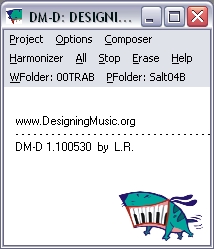 |
- It is an
Algorithmic Music compiler and generator, based on Generative Music
Paradigm, and designed to obtain the most flexibility with the simplest as
possible programming. It also includes a whole harmonization module,
which works after the formal-thematic contents are generated. The reason for
this order is to conform to "Designing Music" principles.
- DM-D is an
evolution of a previous compiler called CSalg, also developed by
Luis
Robles in collaboration with
LIEM
(Laboratory for Electronic and Computer Music, from Culture Ministry of
Spain), in 1994. It was created to generate Score Files for
CSound
using a similar sintax than in Orchestra Files. The same code of Csound
compiler was used also to program Csalg. |
|
|
- DM-D comprises arround 9000 program lines, developped and tested
during 5 years, starting in 2004. The software concentrates only on data
processing, it means, other tasks as music edition, html edition
or file handling must be done by external programs. Code lines are
distributed as follows:
- Composer Module: 35 %
- Harmonizer Module: 65 %
- Interface: less than 1 %
Composer
Module:
- As explained, parts of CSalg code (the compiler core, originally
inspired in
Csound's one) were used for Composer Module. As
CSound, and other Generative
Music software, it is based in generators, which activity is controlled
by different parameters. And all theese parameters are variables which can be modulated
from other generators. Music fragments from a score editor can also be
added as "wave shape" of generators.
Harmonizer Module:
- The Harmonizer Module is the most complex part of the software. It
uses a large amount of recursive functions to try applying harmonization as a human
brain would do, evaluating thousands of situations for each harmony link. It is able to manage non-harmonic tones
in a right way, and to detect
hidden melodic lines into arpeggios, in order to be treated as such. It
also includes
special functions to handle bass and melody lines.
Interface:
- The interface is simple, just a compiler console and the menu
orders, as edition tasks and file handling are left out to be done by external
programs. Theese are:
- Html Editor for Composer programming.
Blocknote freeware editor
is optimal and included in DM-D installation.
- Score editor with
XML
exporting features (like
Finale,
Sibelius or
freeware MuseScore). Necessary for Composer and Harmonizer
programming, and also to display DM-D output files.
- DM-D is actually avaliable in English and Spanish languages.
|